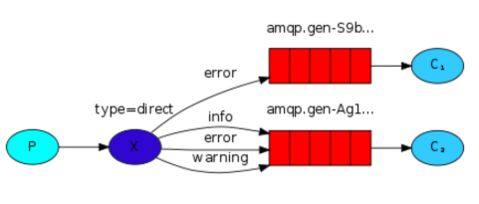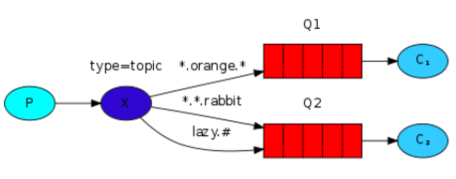RabbitMQ
1概念
RabbitMQ是一个在AMQP基础上完整的,可复用的企业消息系统。他遵循Mozilla Public License开源协议。
MQ全称为Message Queue, 消息队列(MQ)是一种应用程序对应用程序的通信方法。应用程序通过读写出入队列的消息(针对应用程序的数据)来通信,而无需专用连接来链接它们。消 息传递指的是程序之间通过在消息中发送数据进行通信,而不是通过直接调用彼此来通信,直接调用通常是用于诸如远程过程调用的技术。排队指的是应用程序通过 队列来通信。队列的使用除去了接收和发送应用程序同时执行的要求。
2.RabbitMQ安装
安装配置epel源 $ rpm -ivh http://dl.fedoraproject.org/pub/epel/6/i386/epel-release-6-8.noarch.rpm 安装erlang $ yum -y install erlang 安装RabbitMQ $ yum -y install rabbitmq-server
注意:service rabbitmq-server start/stop
安装API
pip install pika or easy_install pika or 源码 https://pypi.python.org/pypi/pika
使用API操作RabbitMQ
基于Queue实现生产者消费者模型

#!/usr/bin/env python # -*- coding:utf-8 -*- import Queue import threading message = Queue.Queue(10) def producer(i): while True: message.put(i) def consumer(i): while True: msg = message.get() for i in range(12): t = threading.Thread(target=producer, args=(i,)) t.start() for i in range(10): t = threading.Thread(target=consumer, args=(i,)) t.start()
对于RabbitMQ来说,生产和消费不再针对内存里的一个Queue对象,而是某台服务器上的RabbitMQ Server实现的消息队列。

#!/usr/bin/env python import pika # ######################### 生产者 ######################### connection = pika.BlockingConnection(pika.ConnectionParameters( host='localhost')) channel = connection.channel() channel.queue_declare(queue='hello') channel.basic_publish(exchange='', routing_key='hello', body='Hello World!') print(" [x] Sent 'Hello World!'") connection.close() 1 2 3 4 5 6 7 8 9 10 11 12 13 14 15 16 17 18 19 20 #!/usr/bin/env python import pika # ########################## 消费者 ########################## connection = pika.BlockingConnection(pika.ConnectionParameters( host='localhost')) channel = connection.channel() channel.queue_declare(queue='hello') def callback(ch, method, properties, body): print(" [x] Received %r" % body) channel.basic_consume(callback, queue='hello', no_ack=True) print(' [*] Waiting for messages. To exit press CTRL+C') channel.start_consuming()
1、acknowledgment 消息不丢失
no-ack = False,如果消费者遇到情况(its channel is closed, connection is closed, or TCP connection is lost)挂掉了,那么,RabbitMQ会重新将该任务添加到队列中。

import pika connection = pika.BlockingConnection(pika.ConnectionParameters( host='10.211.55.4')) channel = connection.channel() channel.queue_declare(queue='hello') def callback(ch, method, properties, body): print(" [x] Received %r" % body) import time time.sleep(10) print 'ok' ch.basic_ack(delivery_tag = method.delivery_tag) channel.basic_consume(callback, queue='hello', no_ack=False) print(' [*] Waiting for messages. To exit press CTRL+C') channel.start_consuming()
2、durable 消息不丢失

#!/usr/bin/env python import pika connection = pika.BlockingConnection(pika.ConnectionParameters(host='10.211.55.4')) channel = connection.channel() # make message persistent channel.queue_declare(queue='hello', durable=True) channel.basic_publish(exchange='', routing_key='hello', body='Hello World!', properties=pika.BasicProperties( delivery_mode=2, # make message persistent )) print(" [x] Sent 'Hello World!'") connection.close()

#!/usr/bin/env python # -*- coding:utf-8 -*- import pika connection = pika.BlockingConnection(pika.ConnectionParameters(host='10.211.55.4')) channel = connection.channel() # make message persistent channel.queue_declare(queue='hello', durable=True) def callback(ch, method, properties, body): print(" [x] Received %r" % body) import time time.sleep(10) print 'ok' ch.basic_ack(delivery_tag = method.delivery_tag) channel.basic_consume(callback, queue='hello', no_ack=False) print(' [*] Waiting for messages. To exit press CTRL+C') channel.start_consuming()
3、消息获取顺序
默认消息队列里的数据是按照顺序被消费者拿走,例如:消费者1 去队列中获取 奇数 序列的任务,消费者1去队列中获取 偶数 序列的任务。
channel.basic_qos(prefetch_count=1) 表示谁来谁取,不再按照奇偶数排列

#!/usr/bin/env python # -*- coding:utf-8 -*- import pika connection = pika.BlockingConnection(pika.ConnectionParameters(host='10.211.55.4')) channel = connection.channel() # make message persistent channel.queue_declare(queue='hello') def callback(ch, method, properties, body): print(" [x] Received %r" % body) import time time.sleep(10) print 'ok' ch.basic_ack(delivery_tag = method.delivery_tag) channel.basic_qos(prefetch_count=1) channel.basic_consume(callback, queue='hello', no_ack=False) print(' [*] Waiting for messages. To exit press CTRL+C') channel.start_consuming()
4、发布订阅

发布订阅和简单的消息队列区别在于,发布订阅会将消息发送给所有的订阅者,而消息队列中的数据被消费一次便消失。所以,RabbitMQ实现发布和订阅时,会为每一个订阅者创建一个队列,而发布者发布消息时,会将消息放置在所有相关队列中。
exchange type = fanout

#!/usr/bin/env python import pika import sys connection = pika.BlockingConnection(pika.ConnectionParameters( host='localhost')) channel = connection.channel() channel.exchange_declare(exchange='logs', type='fanout') message = ' '.join(sys.argv[1:]) or "info: Hello World!" channel.basic_publish(exchange='logs', routing_key='', body=message) print(" [x] Sent %r" % message) connection.close()

#!/usr/bin/env python import pika connection = pika.BlockingConnection(pika.ConnectionParameters( host='localhost')) channel = connection.channel() channel.exchange_declare(exchange='logs', type='fanout') result = channel.queue_declare(exclusive=True) queue_name = result.method.queue channel.queue_bind(exchange='logs', queue=queue_name) print(' [*] Waiting for logs. To exit press CTRL+C') def callback(ch, method, properties, body): print(" [x] %r" % body) channel.basic_consume(callback, queue=queue_name, no_ack=True) channel.start_consuming()
5、关键字发送

exchange type = direct
之前事例,发送消息时明确指定某个队列并向其中发送消息,RabbitMQ还支持根据关键字发送,即:队列绑定关键字,发送者将数据根据关键字发送到消息exchange,exchange根据 关键字 判定应该将数据发送至指定队列。

#!/usr/bin/env python import pika import sys connection = pika.BlockingConnection(pika.ConnectionParameters( host='localhost')) channel = connection.channel() channel.exchange_declare(exchange='direct_logs', type='direct') result = channel.queue_declare(exclusive=True) queue_name = result.method.queue severities = sys.argv[1:] if not severities: sys.stderr.write("Usage: %s [info] [warning] [error] " % sys.argv[0]) sys.exit(1) for severity in severities: channel.queue_bind(exchange='direct_logs', queue=queue_name, routing_key=severity) print(' [*] Waiting for logs. To exit press CTRL+C') def callback(ch, method, properties, body): print(" [x] %r:%r" % (method.routing_key, body)) channel.basic_consume(callback, queue=queue_name, no_ack=True) channel.start_consuming()

#!/usr/bin/env python import pika import sys connection = pika.BlockingConnection(pika.ConnectionParameters( host='localhost')) channel = connection.channel() channel.exchange_declare(exchange='direct_logs', type='direct') severity = sys.argv[1] if len(sys.argv) > 1 else 'info' message = ' '.join(sys.argv[2:]) or 'Hello World!' channel.basic_publish(exchange='direct_logs', routing_key=severity, body=message) print(" [x] Sent %r:%r" % (severity, message)) connection.close()
6、模糊匹配

exchange type = topic
在topic类型下,可以让队列绑定几个模糊的关键字,之后发送者将数据发送到exchange,exchange将传入”路由值“和 ”关键字“进行匹配,匹配成功,则将数据发送到指定队列。
- # 表示可以匹配 0 个 或 多个 单词
- * 表示只能匹配 一个 单词
发送者路由值 队列中 www.abc.com www.* -- 不匹配 www.abc.com www.# -- 匹配

#!/usr/bin/env python import pika import sys connection = pika.BlockingConnection(pika.ConnectionParameters( host='localhost')) channel = connection.channel() channel.exchange_declare(exchange='topic_logs', type='topic') result = channel.queue_declare(exclusive=True) queue_name = result.method.queue binding_keys = sys.argv[1:] if not binding_keys: sys.stderr.write("Usage: %s [binding_key]... " % sys.argv[0]) sys.exit(1) for binding_key in binding_keys: channel.queue_bind(exchange='topic_logs', queue=queue_name, routing_key=binding_key) print(' [*] Waiting for logs. To exit press CTRL+C') def callback(ch, method, properties, body): print(" [x] %r:%r" % (method.routing_key, body)) channel.basic_consume(callback, queue=queue_name, no_ack=True) channel.start_consuming()

#!/usr/bin/env python import pika import sys connection = pika.BlockingConnection(pika.ConnectionParameters( host='localhost')) channel = connection.channel() channel.exchange_declare(exchange='topic_logs', type='topic') routing_key = sys.argv[1] if len(sys.argv) > 1 else 'anonymous.info' message = ' '.join(sys.argv[2:]) or 'Hello World!' channel.basic_publish(exchange='topic_logs', routing_key=routing_key, body=message) print(" [x] Sent %r:%r" % (routing_key, message)) connection.close()
